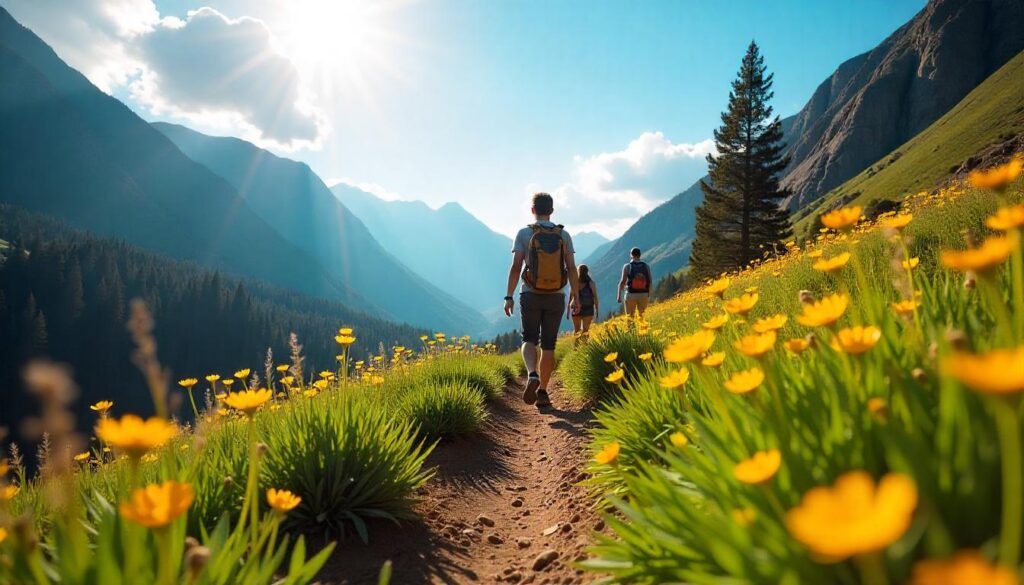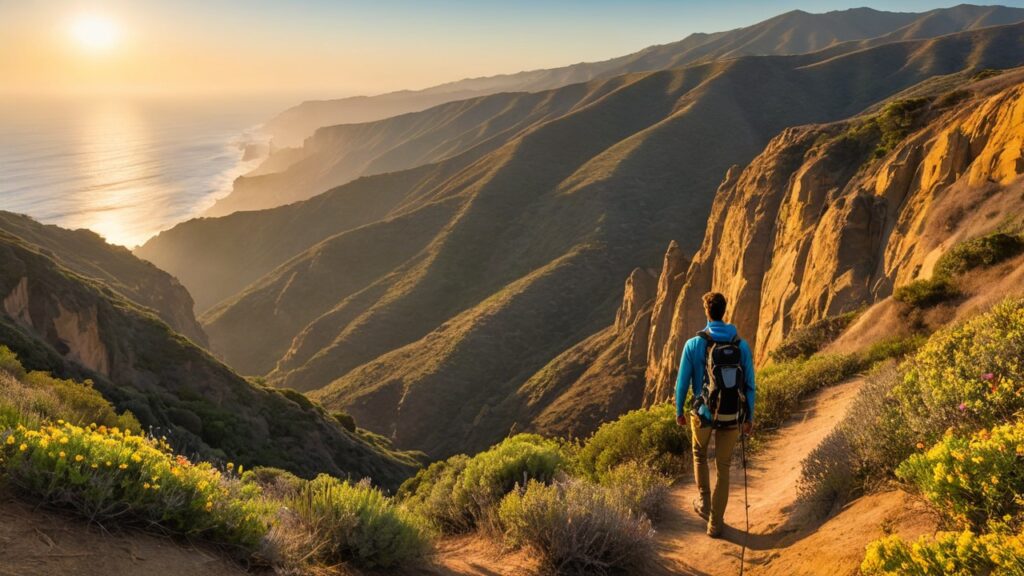
Introduction to Hiking in Malibu CA
Nestled along the sun-kissed coast of Southern California, hiking in Malibu offers an unparalleled blend of rugged canyon trails, sweeping ocean vistas, and hidden waterfalls. Whether you’re a seasoned backpacker searching for adventure or a family looking for a gentle nature walk, Malibu hiking trails deliver unforgettable experiences. From the twisting switchbacks of the Solstice Canyon Loop Trail to the tidal pools of Point Dume Cove Trail, each path reveals a unique side of this coastal paradise. As you lace up your boots, you’re stepping into over 100 miles of interconnected Malibu hiking spots that weave through the Santa Monica Mountains, offering everything from panoramic summit views to serene creekside escapes.
This guide to best hikes in Malibu will equip you with insider tips—from when to visit for whale watching at Point Dume to the optimal gear for traversing rocky canyon floors. We’ll point out expert-recommended routes and practical advice on avoiding peak crowds, so you can fully immerse yourself in the natural beauty that makes hiking in Malibu California a must-do for outdoor enthusiasts. Whether you plan to explore coastal bluff trails, descend into shady canyons, or chase waterfalls, our Ultimate Guide to Hiking in Malibu has you covered with reliable, up-to-date information.
Why Hiking in Malibu Is Unique: Malibu Canyons, Ocean Views & Waterfalls
One of the most compelling reasons to choose hiking places in Malibu is the dramatic contrast between mountain and sea within a single trail network. Here’s what sets this area apart:
- Malibu Canyons
Winding through the heart of the Santa Monica range, Malibu’s canyons—such as Solstice Canyon and Tuna Canyon—offer lush, shaded corridors lined with oak woodlands and native wildflowers. These canyon hikes deliver a refreshing escape from coastal heat and showcase local ecosystems thriving in the coastal Mediterranean climate. According to the National Park Service, Solstice Canyon receives over 200,000 visitors annually, drawn by its mix of historical ruins and verdant canyon floors . - Ocean Views
Few hiking destinations can boast Pacific panoramas at every turn. Trails like the Point Dume Cove Trail and El Matador Beach Coastal Trail climb gently to cliffside overlooks, where you can watch waves crash against sea stacks or spot migrating gray whales between December and April. Seasoned hikers recommend starting these trails early—by 7 a.m.—to avoid the midday sun and catch the ocean light at its most vibrant. - Waterfall Encounters
Malibu’s seasonal streams carve through sandstone, creating hidden cascades like the twin tiers of Escondido Falls. These waterfall hikes blend moderate exercise with the reward of a cool, misty grotto—ideal for a midday rest. For safety, carry waterproof footwear and check seasonal flow rates via the Los Angeles County Parks website before embarking .
Top 10 Hiking Places in Malibu that you should visit
Malibu is famous for its beaches, but it’s also a paradise for hikers. These hiking places in Malibu range from coastal cliff walks to shaded canyon trails with waterfalls. We’ve rounded up the best hikes in Malibu that showcase ocean views, hidden cascades, and historic ruins – all within striking distance of Los Angeles. Below, you’ll find practical tips and expert advice for each trail to help plan your adventure safely and enjoyably.
1. Backbone Trail (Malibu Segment)

Introduction:
The Backbone Trail is Malibu’s epic ridge-top hike, traversing the Santa Monica Mountains from Point Mugu to Will Rogers Park. On the Malibu segment, this trail snakes through Malibu Creek State Park and Zuma Canyon, offering nearly continuous panoramic ocean views. Hikers experience coastal sage scrub, rolling chaparral and oak woodlands as the path undulates along mountain summits. From grassy overlooks near Sandstone Peak (the range’s 3,111-foot high point) to quiet chaparral canyons, the scenery feels remote and wild.
Trail Distance, Elevation, Difficulty, and Permit:
- Distance: ~67.8 miles (hikers typically do day segments)
- Elevation Gain: up to 3,111 ft (highest point near Sandstone Peak)
- Difficulty: Strenuous (long, rugged with many climbs)
- Permit: No permit required (NPS/park day-use fees may apply)
Best Time to Visit
Late fall through spring is ideal for cooler weather and clearer air. Spring wildflowers can carpet the canyons, and on clear days the ocean views are spectacular. Avoid peak summer heat.
Personal Tips & Safety Precautions
- Plan segments rather than trying the whole trail at once.
- Bring ample water and snacks, as shaded sections are rare.
- Wear sturdy boots for uneven terrain and watch for rattlesnakes, especially in spring and fall.
- Let someone know your route and estimated return time.
- Terrain is rugged, so trekking poles can help on steep sections.
2. Malibu Creek State Park (Rock Pool & Century Lake Loop)
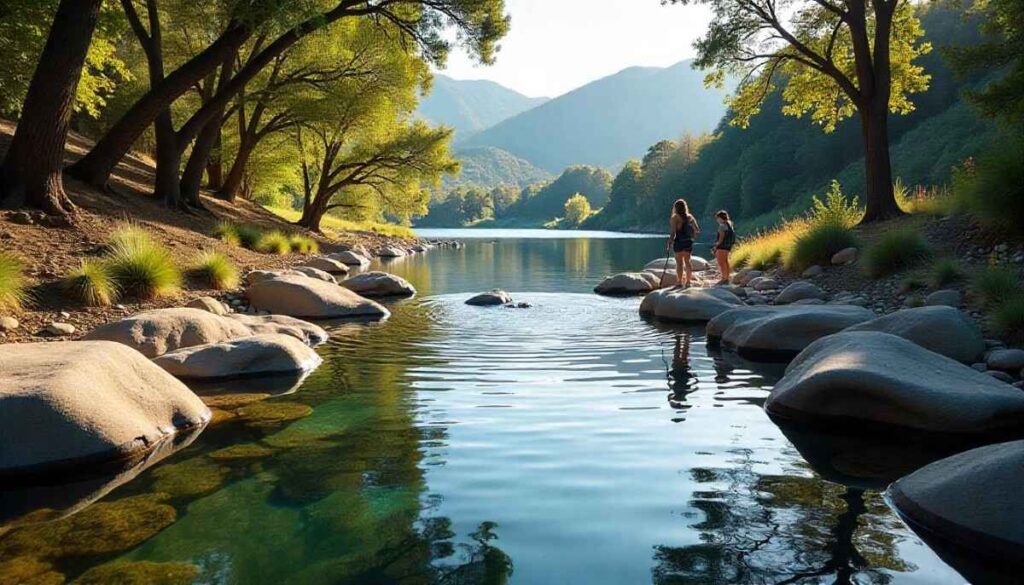
Introduction:
Malibu Creek State Park offers a lush oasis hike amid the mountains. The loop to the Rock Pool and Century Lake leads through oak groves and fern-lined creek beds, ending at a scenic spring-fed lake. This Malibu Creek hike is famous for its carved rock pools (great for wading on hot days) and a dramatic backdrop of sandstone ridges. The trail weaves past the old MAS*H filming site and the ruins of historic ranch structures, blending Hollywood history with nature. With the creek trickling alongside much of the route, the shaded canyon feels cool even in summer. It’s one of the best hikes in Malibu for families and day-trippers, featuring gentle slopes and a natural swimming spot.
Trail Distance, Elevation, Difficulty, and Permit:
- Distance: ~3.5 miles loop (Rock Pool + Century Lake)
- Elevation Gain: ~500 ft (gentle hills)
- Difficulty: Easy/Moderate (well-marked, family-friendly)
- Permit: None (California State Parks day-use fee applies)
Best Time to Visit
Late spring through summer is great for warm weather and a cool dip in the Rock Pool. Wildflowers bloom in spring, and the shade is welcome on hot days.
Personal Tips & Safety Precautions
- Bring swimming gear and a towel if you plan to swim – the rock pool is inviting but the water can be cold.
- Carry extra water even though much of the hike is shaded.
- Wear sturdy shoes, as some sections have slippery wet rocks.
- Keep dogs on leash (they’re allowed here).
3. Escondido Falls Trail
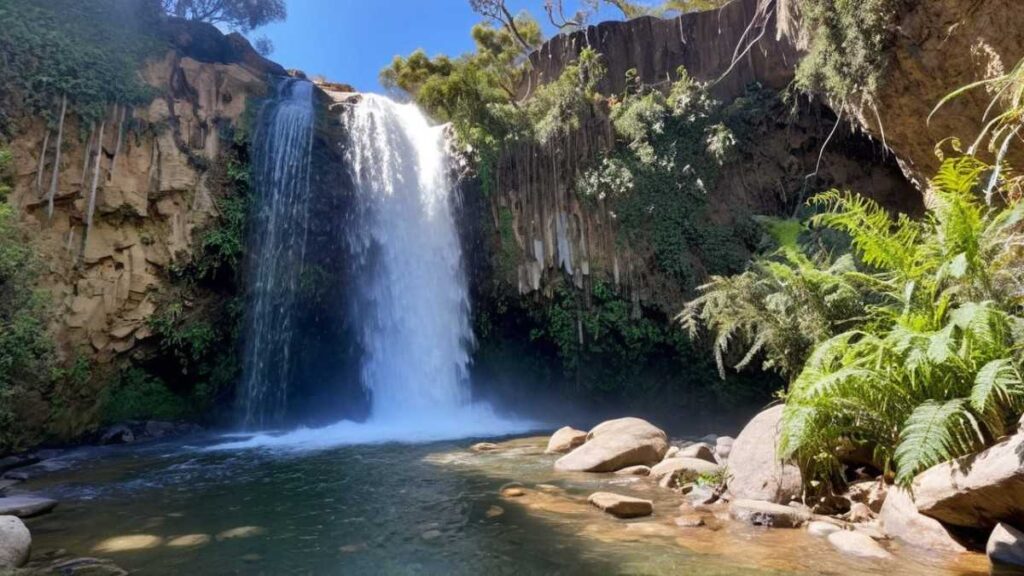
Introduction:
This classic waterfall hike in Malibu leads to a stunning two-tiered cascade. Escondido Falls plunges nearly 150 feet in a shaded canyon – the tallest waterfall in the Santa Monica Mountains. The trail starts amid oak and sycamore trees, then follows a sandy creekbed that becomes a fern-covered corridor. The lush greenery and rocky overhangs give the hike a jungle-like feel. In the rainy season, powerful flows descend over mossy cliffs; in late spring the base pool invites wading. The trail to the first falls is easy, but reaching the upper falls involves a short scramble (unofficial ropes may be present). Because of the waterfall reward, this is a must-do hike in Malibu for nature lovers. The combination of cool canyon air and the dramatic falls makes it one of the most memorable Malibu waterfall hiking trails.
Trail Distance, Elevation, Difficulty, and Permit:
- Distance: ~3.8 miles round-trip
- Elevation Gain: ~600 ft
- Difficulty: Moderate (easy to first falls; moderate to upper falls with a scramble)
- Permit: None (no special permit needed)
Best Time to Visit
Winter and early spring (December–April) are best, when rainfall fills the falls. After heavy rains, the waterfall is impressive. Late spring still has flow and wildflowers.
Personal Tips & Safety Precautions
- Wear good hiking shoes: the creekbed can be uneven and the scramble to the upper falls is steep and slippery.
- Bring plenty of water and sun protection, especially in summer when the canyon can heat up.
- Dogs are allowed on leash, but be cautious around the water.
- The trail is popular, so parking can be full – consider visiting on weekdays or early in the morning.
- Finally, carry out all trash and treat the area respectfully; heavy foot traffic has affected the falls environment.
4. Solstice Canyon Loop Trail
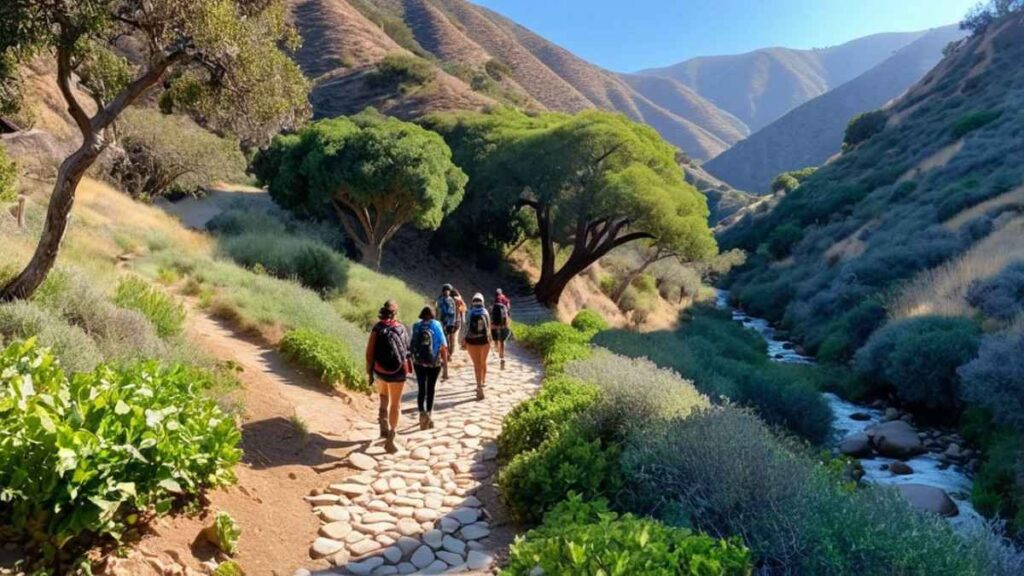
Introduction:
The Solstice Canyon Loop Trail is a beautiful, family-friendly hike with historic landmarks. It winds through a cool oak canyon to an ocean overlook, passing the ruins of the Roberts Ranch house and an old stone cottage. The trail features a year-round stream (and a small waterfall) even in dry months. Shaded by mature oaks and sycamores, the hike feels peaceful and green. In winter the waterfall by the house ruins flows, while spring brings wildflowers in meadows. This easy loop is one of the most popular hikes in Malibu, California thanks to its low effort and high scenery.
Trail Distance, Elevation, Difficulty, and Permit:
- Distance: ~3.1 miles loop (round-trip)
- Elevation Gain: ~600 ft
- Difficulty: Easy to Moderate (mostly flat with one hill)
- Permit: None (state park day-use pass required)
Best Time to Visit
Solstice Canyon is great year-round. Springtime offers wildflowers and a flowing waterfall. Even in summer or fall, the canyon’s shade keeps the trail cool. For clear ocean views, pick a day after marine layer lifts (often late morning).
Personal Tips & Safety Precautions
- Bring ample water and sun protection – while much of the trail is shaded, parts of the loop climb into exposed ridgelines.
- On rainy days, trail sections can become muddy; good traction footwear is recommended.
- Leashed dogs are welcome, so you can make it a pet-friendly outing.
- Check the restroom availability before you start.
5. Point Dume Cove Trail
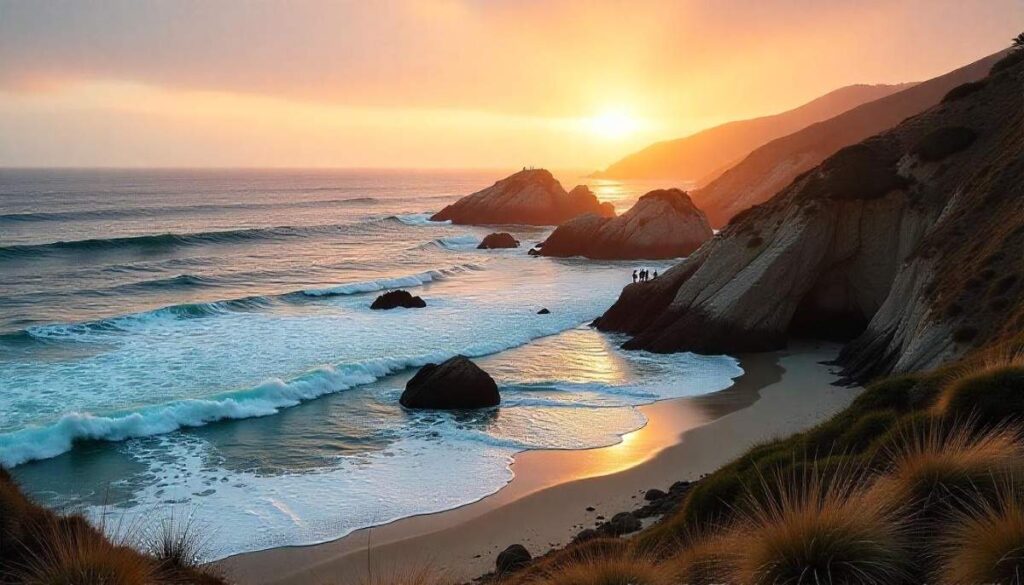
Introduction:
The Point Dume Cove Trail offers stunning coastal hikes at Malibu’s western edge. This short trail follows bluffs high above the Pacific, leading to a quiet sandy cove sheltered by sandstone cliffs. Ocean vistas stretch to Catalina Island; wintertime whale sightings are common. The path begins at Point Dume Natural Preserve and gently descends to the beach. Towering cliffs to your right and open sea to your left make this hike feel like an island escape. It’s one of Malibu’s best beach hikes, combining panoramic surf views with easy walking. The end reward is a little cove (Dume Cove) perfect for tidepooling or relaxing on the sand.
Trail Distance, Elevation, Difficulty, and Permit:
- Distance: ~2.5 miles round-trip (to Point Dume Cove and back)
- Elevation Gain: ~300 ft (gentle descent/ascent)
- Difficulty: Easy (mostly flat, dirt and sandy trail)
- Permit: None (parking permit or day-use fee applies at the preserve)
Best Time to Visit
Sunrise or sunset are spectacular here, with golden light on the cliffs. Late fall through spring are ideal for clear skies and cool hiking. In summer the trail can be hot and windy on the bluff – bring layers.
Personal Tips & Safety Precautions
- If you have a drone, note that beaches in Malibu often have flying restrictions.
- The parking lot atop Point Dume is small; arrive early or be prepared to park along Pacific Coast Highway.
- For families, keep a close eye on children near the cliffs and water.
- Dogs are allowed on leash, but be mindful of wildlife and clean up after pets.
6. Zuma Canyon Trail

Introduction:
Zuma Canyon Trail is a hidden gem of Malibu’s mountain hikes, known for its sweeping views and quiet wilderness. Starting from a remote trailhead, it climbs steadily through chaparral and oak forests. Mid-hike, you crest Zuma Ridge for a spectacular lookout over Zuma Beach, Malibu Lake and the mountains. From the ridge top, the ridge descends back into Malibu Creek State Park. Along the way, you’ll see varied terrain: shaded creekside groves, grassy meadows, and rugged ridgeline. Few tourists venture here, so you’ll enjoy solitude and a true backcountry feel. This moderate loop (often done clockwise) is among Malibu’s most scenic hikes for experienced hikers.
Trail Distance, Elevation, Difficulty, and Permit:
- Distance: ~6.5 miles loop (combining Zuma and Corral Canyon trails)
- Elevation Gain: ~1,100 ft
- Difficulty: Moderate (steady uphill sections, exposed ridges)
- Permit: No permit (Santa Monica Mountains National Recreation Area / NPS pass required)
Best Time to Visit
Spring and fall are ideal – cooler temps and wildflowers on the ridgeline. Winter is also good (fewer bugs and clear air), but trails can be slick after rain. Summer mornings can work, but pack heat protection for the exposed climb.
Personal Tips & Safety Precautions
- This is a long hike: pack at least 2 liters of water per person.
- The trail is well-marked, but carry a map or app just in case, as forks can be confusing.
- There is little shade on Zuma Ridge, so sun protection is essential.
- Trail is open to dogs (leash required).
- Keep an eye out for rattlesnakes on warm days, and give them a wide berth. Because it’s remote, let someone know your plans or hike with a buddy.
7. Malibu Lake Trail
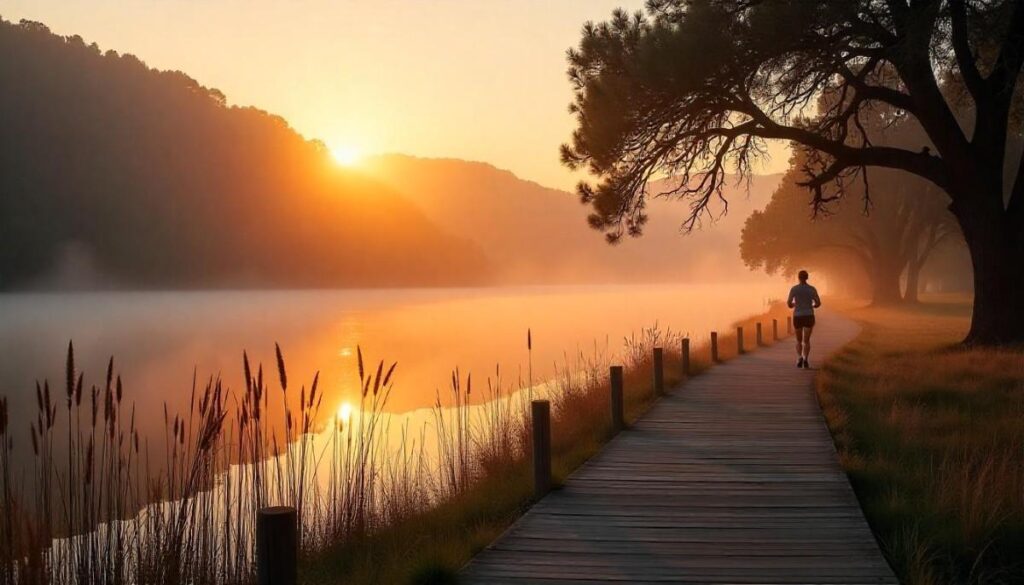
Introduction:
Malibu Lake Trail (near Calabasas) circles a serene reservoir and climbs a gentle ridge for great views. The path follows the rippling Malibu Creek upstream to the Malibu Lake reservoir and back. Towering eucalyptus and oaks line the early portion, giving way to open chaparral with vistas of the lake. Birdwatchers will enjoy ducks and herons on the water. In late spring, wildflowers bloom on the hills. The trail is moderately challenging but well-graded, making it one of Malibu Creek State Park’s top hikes.
Trail Distance, Elevation, Difficulty, and Permit:
- Distance: ~6.4 miles round-trip (out-and-back)
- Elevation Gain: ~1,000 ft
- Difficulty: Moderate (steady, but not steep)
- Permit: None (Park day-use fee required)
Best Time to Visit
After rains (late winter to spring) for full lake and creek flow, and for spring wildflowers on the ridge. Fall is also beautiful, with cooler, clear skies. Summer mornings are pleasant by the water.
Personal Tips & Safety Precautions
- This popular trail is dog-friendly on leash, so you might see many canine companions – great for social dogs!
- The western portion has poison oak in places – learn its look and avoid it.
- Hiking poles can help on the final climb if you prefer.
- Swimmers sometimes jump in the lake – it’s deep and chilly, so be cautious if tempted.
- Finally, cell signal may drop on the ridge; consider a physical map if you plan to roam beyond the main route.
8. Parker Mesa Overlook (Park Mesa Overlook)
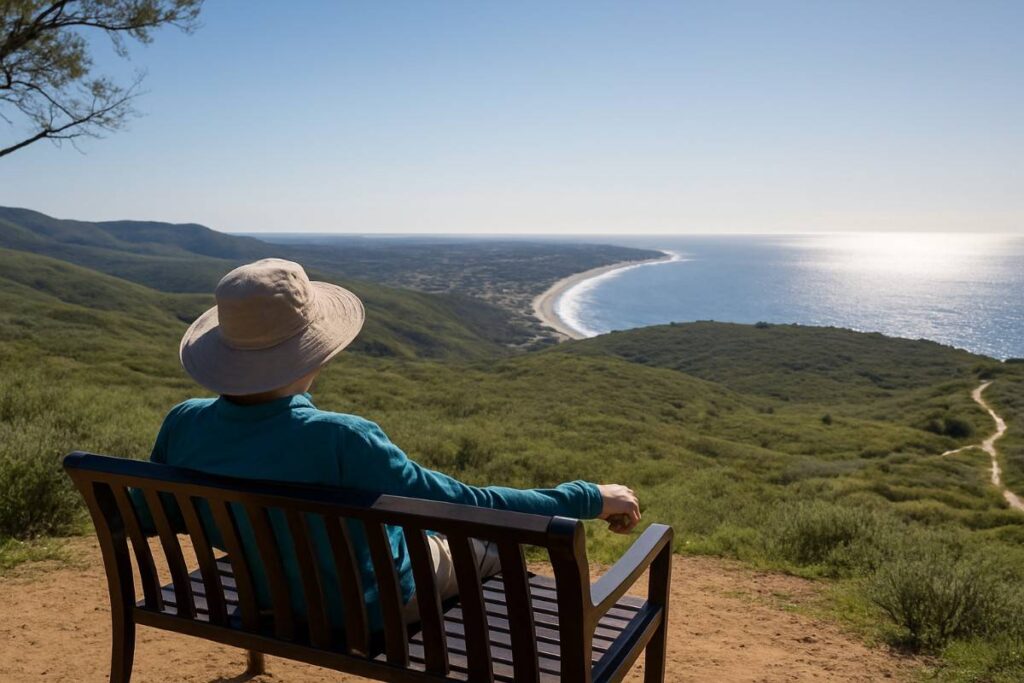
Introduction:
Parker Mesa Overlook is a famous ocean-view summit in the Santa Monica Mountains, offering 360° panoramas over Malibu and the Pacific. The hike winds through coastal sage and golden grasslands to a grassy bluff atop the ridge. From here you can see the rocky coastline, blue ocean, and even downtown LA on clear days. In winter, the hillsides burst with wildflowers. Sunset is spectacular as the sun dips into the Pacific. This moderate loop provides a classic Malibu experience: open sky, salty breezes and rolling hills. It’s often cited as one of the most scenic hikes in Malibu for its expansive views.
Trail Distance, Elevation, Difficulty, and Permit:
- Distance: ~5.6 miles loop (Park Mesa Overlook Loop)
- Elevation Gain: ~650 ft
- Difficulty: Moderate (gentle inclines with one open ridge)
- Permit: None (NPS day-use fee at parking)
Best Time to Visit
Sunset is magical here, but mid-morning light gives good photos too. Spring (March-May) has abundant wildflowers. Fall offers clear skies and cooler temps.
Personal Tips & Safety Precautions
- The summit is exposed: wear a windbreaker for gusty conditions and sunscreen for the lack of shade.
- Bugs can be minimal at the overlook, but some areas have ticks; check for them afterward.
- There are no water sources en route, so bring water. The dirt paths can be dusty; gaiters or bandanas help if wind kicks up.
- Park at the small lot (the only trailhead access) – it fills early, so plan to arrive before 9am or after 4pm.
9. Temescal Canyon Trail

Introduction:
Though technically in Pacific Palisades, Temescal Canyon is often enjoyed by Malibu hikers for its stunning beach and ridge views. This loop trail climbs from a shaded canyon up to a high ridge overlooking the Pacific. The first half winds through a fern-lush creek area with a seasonal waterfall; then it switchbacks onto Temescal Ridge with sweeping vistas of the coastline and downtown LA skyline. The contrast of cool canyon floor and exposed ridge makes it a dynamic hike. It’s a well-loved ocean view hike near Malibu, popular for its relatively easy access and dramatic payoff at the top. The wilderness feel is enhanced by fragrant sages and abundant wildflowers in spring.
Trail Distance, Elevation, Difficulty, and Permit:
- Distance: ~3.3 miles loop (Primrose and Temescal Ridge)
- Elevation Gain: ~600 ft
- Difficulty: Moderate (steep hill, but short)
- Permit: None (free parking in lot, but arrives early)
Best Time to Visit
Spring offers colorful wildflower blooms along the ridge. Summer mornings are pleasant in the shaded canyon, but the ridge can be very hot – go early or late. Fall has cooler air and often the clearest ocean views. Winter can have running waterfalls after rainstorms (though bridge crossings may be tricky). Avoid midday in summer to prevent overheating.
Personal Tips & Safety Precautions
- The trailhead parking lot is small; arrive early on weekends or go on a weekday.
- Trail runners use this route, so be aware of fast-moving hikers on switchbacks
- Watch your step on the ridge path, which is narrow and steep in parts.
- If the waterfall is flowing, the bridge crossings can splash; waterproof shoes are a bonus.
- Lastly, poison oak is present – learn to identify it to avoid rash.
10. Nicholas Flat Trail
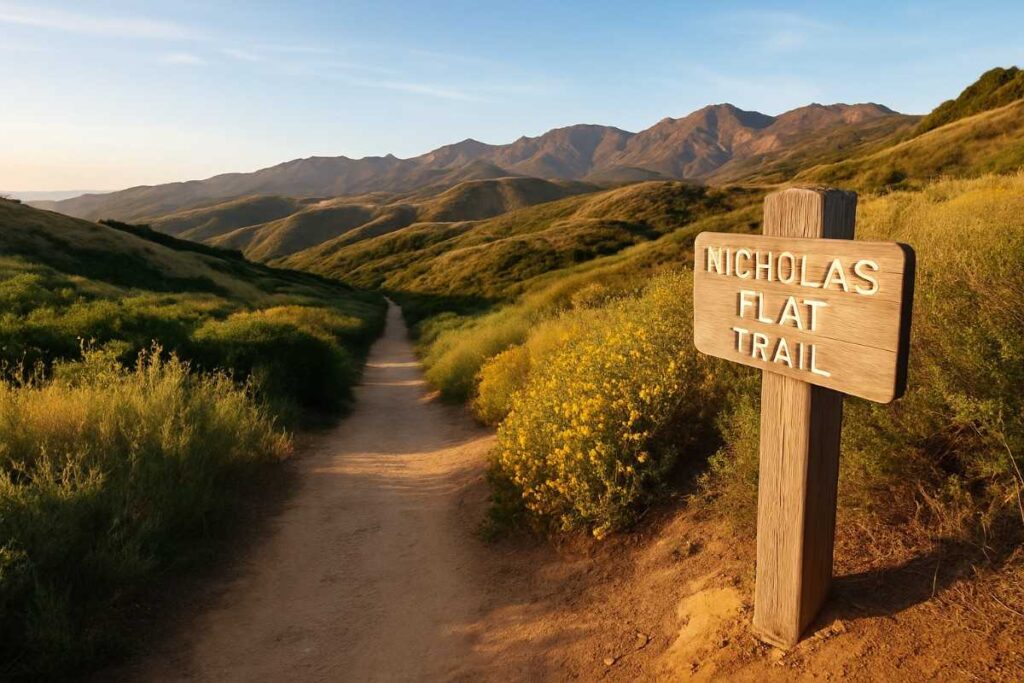
Introduction:
Nicholas Flat Trail is a challenging ridge hike that truly connects Malibu’s coast and mountains. Starting near Leo Carrillo State Park, it climbs 3.2 miles up to a high point overlooking Malibu Canyon. The trail skirts through sand-dune habitats then ascends through chaparral to offer endless views of the Pacific Ocean and Malibu Lake. By the time you reach the ridgeline, you feel above it all – the ocean on one side, Santa Monica Mountains on the other. It’s known as one of Malibu’s best hikes for those who crave elevation and ocean scenery together. Despite its difficulty, many runners and peak-baggers tackle it for the reward of the 360° views from above.
Trail Distance, Elevation, Difficulty, and Permit:
- Distance: 3.2 miles one-way (6.4 mi round-trip)
- Elevation Gain: 1,681 ft
- Difficulty: Difficult (steep and sustained climb)
- Permit: None (no parking permit needed; park respectfully)
Best Time to Visit
Cooler months (fall through spring) are best. Early mornings are ideal – you’ll catch sunrise glinting off the Pacific. Summer afternoons will be hot and exposed; if hiking in warm weather, start at dawn.
Personal Tips & Safety Precautions
- This hike is strenuous: wear supportive shoes and take your time on the ascent.
- Bring plenty of water (more than usual for 6+ miles of hiking).
- On the steep middle section, the trail is narrow and loose in places; trekking poles can aid balance. Dogs on leash are permitted, but the climb is tough for pets – ensure yours is fit for long hikes and carry dog water if needed.
- There is no shade on the ridge, so wear layers and protect against sunburn.
Comparison Table: Top 10 Hiking Places in Malibu
| Trail Name | Distance | Elevation Gain | Difficulty | Best Season | Permit Required |
|---|---|---|---|---|---|
| Backbone Trail (Malibu Segment) | Varies (67 mi total) | Up to 2,000 ft | ⭐️⭐️⭐️⭐️ Hard | Fall to Spring | None |
| Malibu Creek State Park (Rock Pool & Century Lake Loop) | 4.7 miles loop | ~300 ft | ⭐️⭐️⭐️ Moderate | Fall to Spring | None |
| Escondido Falls Trail | 3.8 miles round trip | ~400 ft | ⭐️⭐️⭐️ Moderate | Winter to Spring | None |
| Solstice Canyon Loop Trail | 3.2 miles loop | ~700 ft | ⭐️⭐️⭐️ Moderate | Year-round | None |
| Point Dume Cove Trail | ~1 mile loop | Minimal | ⭐️ Easy | Year-round | None |
| Zuma Canyon Trail | 2.8 to 10 miles | Up to 1,500+ ft | ⭐️⭐️⭐️⭐️ Hard | Fall to Spring | None |
| Malibu Lake Trail | ~3 miles round trip | ~300 ft | ⭐️⭐️ Easy | Fall to Spring | None |
| Parker Mesa Overlook Trail | 7 miles round trip | ~1,300 ft | ⭐️⭐️⭐️ Moderate | Fall to Spring | None |
| Temescal Canyon Trail | 2.6 to 4 miles loop | ~900 ft | ⭐️⭐️⭐️ Moderate | Fall to Spring | None |
| Nicholas Flat Trail | 6 miles round trip | ~1,200 ft | ⭐️⭐️⭐️⭐️ Hard | Fall to Spring | None |
Planning Hiking in Malibu: Tips & Checklist

Before you hit the trails, planning is key. Malibu sits in a warm, dry coastal climate, so always check weather and daylight. Prepare by telling someone your route and expected return time. Carry a basic first-aid kit, map or GPS, and plenty of water. As professional hiker I’d advise you to bring at least 1 quart of water per person even for short hikes. Further insights are mentioned below:
What to Pack for Hiking in Malibu CA
Packing essential gears for hiking is really essential for getting the best experience of hiking in Malibu
- Water & Snacks: Carry ample water (1–2 liters per person) and electrolyte drinks. Pack high-energy snacks (trail mix, fruit) to fuel your hike, especially on longer canyon routes. Staying hydrated and fueled keeps energy up on sun-exposed trails.
- Sun Protection: Sunscreen (SPF 30+), lip balm with SPF, UV-blocking sunglasses, and a sun hat are essential. Even a short hike under Malibu’s sun can lead to burns or heat exhaustion without protection.
- Navigation & Safety: A printed map or GPS device is wise – cell service is spotty in backcountry. Bring a flashlight or headlamp (in case you’re out after dusk), a whistle, and a small first-aid kit for blisters and minor injuries.
- Extra Gear: Include a lightweight rain jacket or fleece (weather can change unexpectedly), multi-tool or pocket knife, and a spare phone battery or power bank. Don’t forget insect repellent and a small camera to capture Malibu’s views. If hiking with dogs, pack extra water and a leash (dogs are allowed on many Malibu trails on leash).
What to Wear for Hiking in Malibu
- Layered Clothing: Wear moisture-wicking shirts and quick-dry pants or shorts. Long sleeves and pants protect against sun, brush, and insects. Choose light colors to stay cool. Remove layers as you warm up.
- Sturdy Footwear: Hiking boots or trail shoes with good grip are a must on rocky, uneven terrain. Trails like Zuma Ridge or Malibu Lake Vista get steep, so solid ankle support helps prevent sprains. Always break in new shoes before a long hike.
- Sun and Eye Protection: A wide-brimmed hat (or cap) and UV-blocking sunglasses are crucial for ocean-view trails like Point Dume or Backbone Trail. Many hikers also use moisture-wicking bandanas or buff neck gaiters for sun and dust protection.
- Accessories: Wear moisture-wicking socks (consider two layers to avoid blisters). Carry a light windbreaker or fleece jacket – coastal mornings and shady canyons can be chilly. Always have a small towel or bandanna to wipe sweat and sun off your face.
For detailed clothing checklist click here.
Best Hiking Camping in Malibu
- Malibu Creek State Park Campground: This park has two camp areas (family and group) with 62 sites, flush toilets and showers. It’s a top pick for hikers – trails like Rock Pool start from here. Camp under oaks and enjoy park ranger programs.
- Leo Carrillo State Park Campground: Nestled by the beach, this campground offers shady sites under sycamores. It’s perfect for combining trail hikes with beach time. From camp you can hike the Nicholas Flat Trail into Malibu’s hills or stroll along tidepools at low tide. Flush toilets and coin showers are available.
- Point Mugu State Park (Sycamore Canyon): Just north of Malibu, Sycamore Canyon has many campsites with bear boxes. Hike from camp to scenic spots like the Sycamore Canyon Falls or up to the ridge with ocean views. (Check Park Service alerts; Sycamore closed if fire danger is high.)
- Others: Nearby, Malibu Beach RV Resort offers tent/RV camping near the coast. Always check fire restrictions and pack out trash. Book early on weekends – Malibu parks fill up quickly.
Other Iconic Hiking Places in Malibu
Corral Canyon Trail

The Corral Canyon Trail is a standout among best hikes in Malibu, offering a harmonious blend of coastal panoramas and mountain wilderness. This 3.0-mile out-and-back route begins at a small pull-off on Pacific Coast Highway, where a modest trailhead sign hints at the adventure ahead. As you climb 600 ft through chaparral and sagebrush, you’ll be treated to sweeping views of the Pacific Ocean and the dramatic Malibu canyons carved into the Santa Monica range.
Early on, the trail winds through oak-studded ridges; listen for the chatter of wrens and towhees among the manzanita. Midway, a bench perched at 1,200 ft elevation makes a perfect rest spot—sip water, savor the salt-tinged breeze, and scan for whales migrating along the coast. On clear days, you can even spot the outline of Catalina Island.
Expert Insight
Local guide Maria Reyes of Malibu Hiking Tours recommends pairing Corral Canyon with a quick stop at nearby Point Dume Cove Trail to round out a half-day of Malibu waterfall hiking trails and coastal vistas.
Tuna Canyon Park Trail
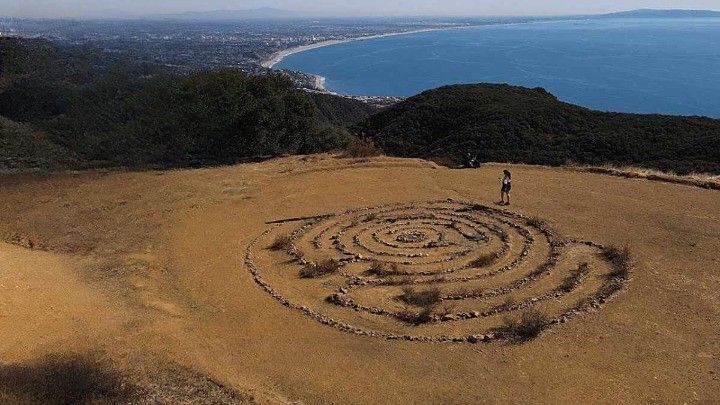
Tucked between the leafy enclaves of Topanga and the Pacific coastline, the Tuna Canyon Park Trail is one of the most rewarding hiking places in Malibu California. This 4.1-mile loop ascends through a shaded oak woodland, offering respite from the sun, then emerges onto chaparral-covered ridges with sporadic views of the ocean. Total elevation gain hovers around 800 ft, making it moderate in difficulty but rich in ecological diversity.
The first mile follows a creekside path; after winter rains you may even spot small cascades feeding ephemeral pools. Birdwatchers prize this stretch for its gatherings of warblers and kinglets. At the midway point, a rocky outcrop known as “Eagle’s Perch” affords a dramatic sea-and-sky panorama — a true ocean view summit Malibu moment. The descent back through fragrant coastal sage washes the palate with fresh air and the scent of wild mint.
Insider Advice
Tuna Canyon is a favorite training ground for local trail runners—if you encounter a group with headlamps at dawn, give them right of way. After your loop, stop at the small picnic area near the trailhead to sample fresh lemonade from a nearby market, a local custom that earns rave reviews on community forums.
Charmlee Wilderness Park Trail
Charmlee Wilderness Park‘s trail network is a hidden gem among Malibu hiking trails. Unlike many coastal hikes, this 532-acre reserve specializes in lush valleys and ocean vistas from modest ridge climbs. The signature Ranch Loop is a 5-mile circuit that gains 650 ft, winding past the historic Roberts Ranch ruins and through pockets of native chaparral restoration.
Wildflowers dominate spring months—calendulas, lupines, and tidy tiger lilies blanket the valley floor. Interpretive signs along the trail detail the park’s efforts to reintroduce the endangered mountain lion’s native prey species. Ocean views peek through saddle clearings, earning Charmlee a spot on lists of great hikes in Malibu.
Expert Insight
Conservation biologist Dr. Elena Kim points out that the Ranch Loop’s mix of riparian corridor and ridgetop is critical habitat for migrating monarch butterflies each fall—bring binoculars and a field guide for an impromptu lepidopterist experience.
Topanga Lookout via Muffins Loop
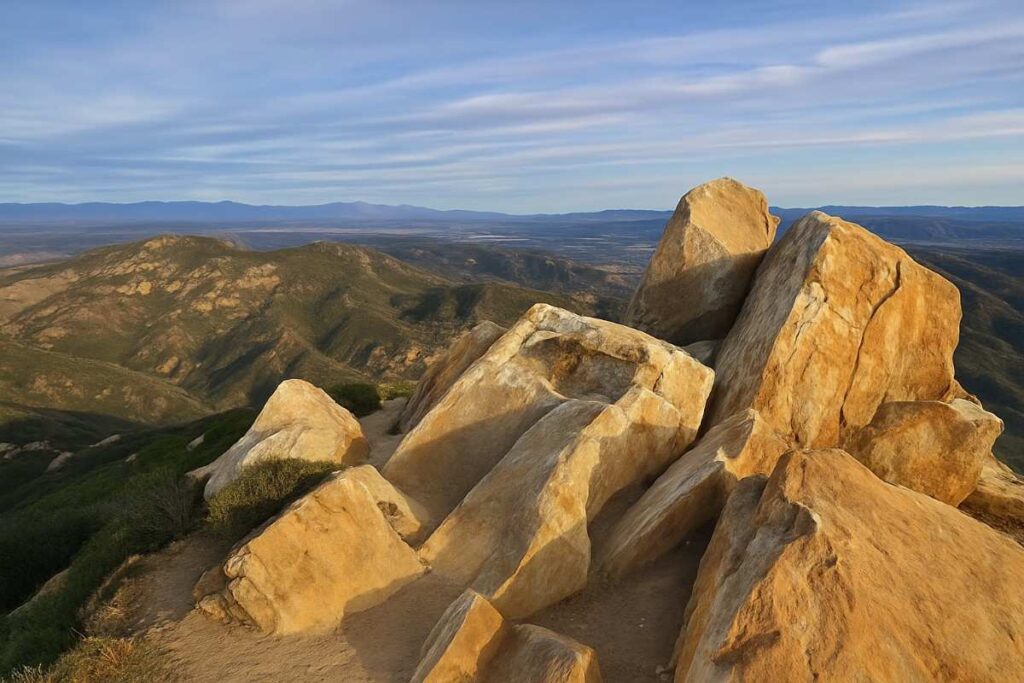
Climbing the Topanga Lookout via Muffins Loop (aka Castle Peak) is a bucket-list experience for serious hiking in Malibu canyon aficionados. This 5.3-mile circuit gains nearly 1,700 ft, culminating in one of the highest accessible points in the Santa Monica Mountains fronting Malibu. At 1,708 ft, the former fire-spotting station provides 360° panoramas — from the Malibu coastline west to the Conejo Valley.
The trail begins with deep shade under laurel and alder trees, transitioning to sun-baked chaparral. Along the ascent, ancient rock outcrops known as “Muffins” (for their rounded shape) dot the ridge — perfect lunch perches. The final quarter mile is exposed; the air thins and breezes grow strong, so layer up even in summer.
Insider Advice
Local ultrarunner Jasmine Lee recommends rallying a small group for safety and motivation; the shared summit experience at dawn is worth planning around new-moon dates for stargazing en route.
El Matador Beach Coastal Trail
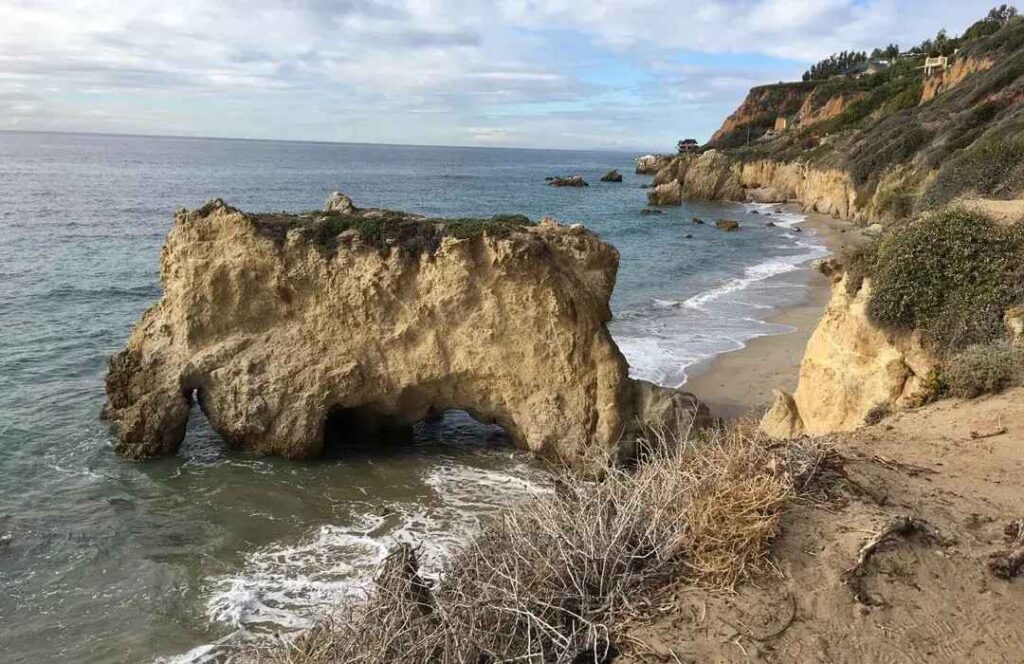
For classic Malibu beach hikes, the El Matador Beach Coastal Trail delivers in spades. This short 1.5-mile out-and-back wanders cliff-top paths, down carved sandstone steps, and through hidden sea caves. Elevation changes are modest (about 150 ft), but the terrain demands careful footing on uneven rock and shifting sand.
The beach below features arches and stacks sculpted by centuries of wave action, creating one of the most photogenic Malibu overlook points. Tide-pooling at low tide reveals starfish and anemones, while whalers once used this cove, a slice of history still whispered by shells in the sand.
Expert Insight
Nature guide Raul Torres notes that gulls and oystercatchers nest on the more inaccessible stacks—binoculars will let you observe these coastal birds without disturbing their habitat.
El Pescador Beach Trail (Leo Carrillo State Park)
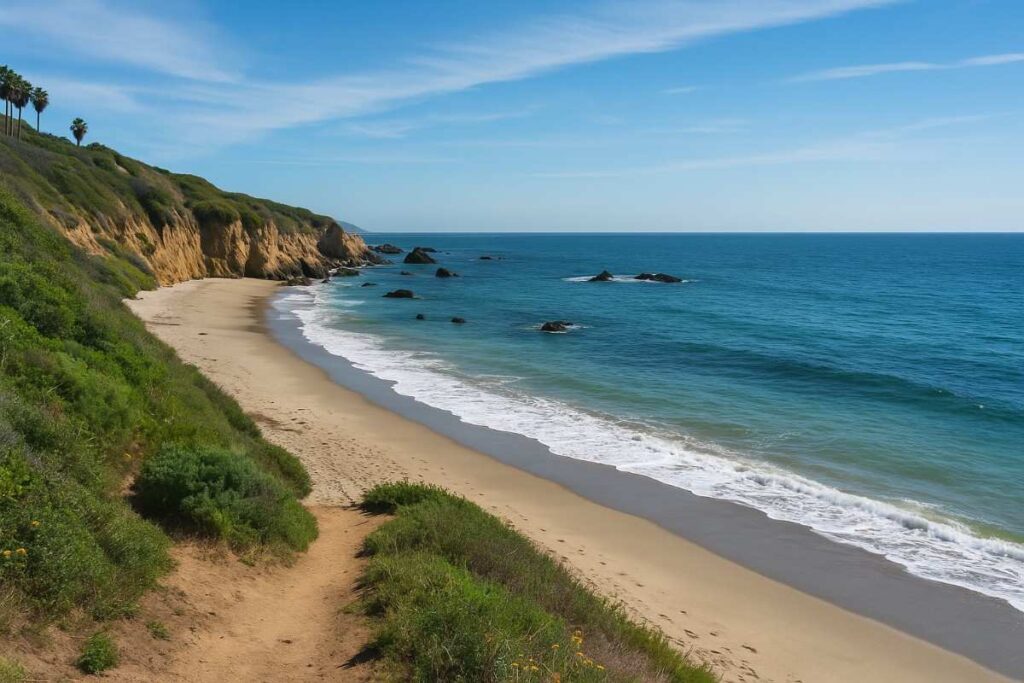
Just north of El Matador lies Leo Carrillo State Park, home to the El Pescador Beach Trail, a 2.2-mile path woven through upland coastal scrub and sheltered groves. Elevation gain is mild (about 200 ft), but the scenery transitions from windswept bluff tops to sheltered tidepools. Winter rains coax small waterfalls down bluff faces—earning this a spot among the Malibu waterfall hiking trails.
The southern end of the loop skirts a lagoon frequented by snowy plovers and herons. Continue north to find hidden caves and sea-arch tunnels carved by centuries of surf.
Community Insight
Park volunteer Nina Patel suggests visiting mid-week in late spring for the best combination of blooming coastal wildflowers and gently flowing bluffside springs, a rare treat on most Malibu beach hiking trails.
Difficulty & Experience Levels
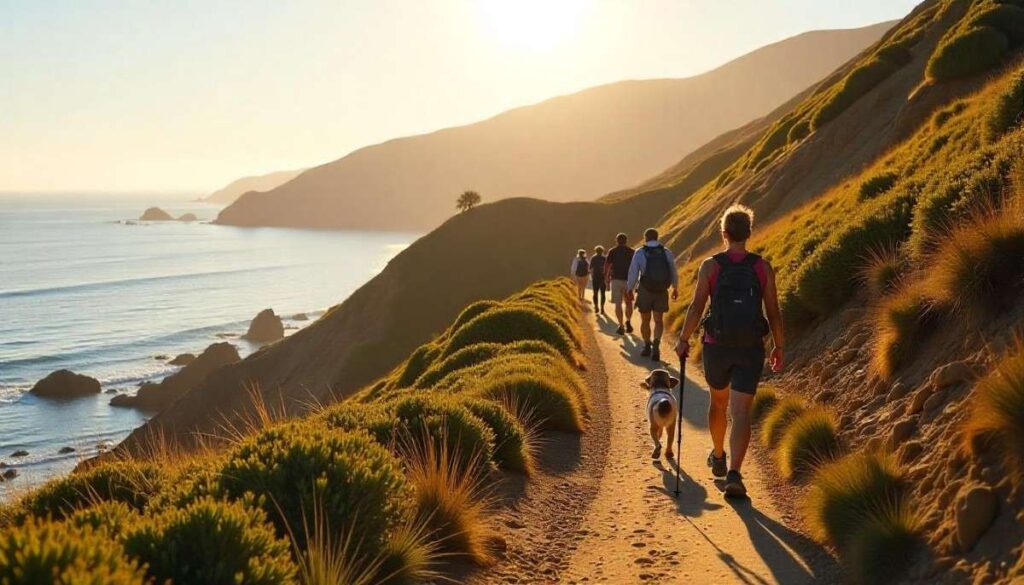
Navigating the rugged terrain of Malibu means choosing hikes that match your fitness, experience, and desired scenery. Whether you’re chasing ocean vistas on a best hikes in Malibu route or seeking family-friendly strolls, Malibu offers trails for every skill level. Below, we break down the options so you can pick the perfect hiking places in Malibu for your next adventure.
Easy Hikes in Malibu (Easy Malibu Hikes)
For those new to hiking in Malibu CA, easy hikes offer gentle terrain and big rewards. Trails like the Point Dume Cove Trail and the Alibu Lake Trail provide well-graded paths, minimal elevation gain, and spectacular coastal panoramas—ideal for beginners or casual walkers. These routes often feature clear signage, nearby parking, and picnic spots, making them perfect for a leisurely morning outing. Always carry water and sun protection, as even “easy” Malibu hikes can be sunbaked.
Moderate & Great Hikes in Malibu
If you’re comfortable on your feet and crave a bit more challenge, moderate hikes such as the Solstice Canyon Loop Trail or the Tuna Canyon Park Trail balance effort with reward. Expect varied surfaces—from sandy washes to rocky ridges—plus steeper sections that offer stunning canyon and ocean views. These great hikes in Malibu typically take 2–4 hours and reveal hidden waterfalls or dramatic overlooks, so pack snacks and a camera to capture those Malibu waterfall hiking trails.
Dog Friendly Hikes Malibu
Many hiking trails in Malibu welcome your four-legged friends, provided they stay on leash. Popular dog friendly hikes Malibu include the easy Charmlee Wilderness Park Trail and the shaded sections of Corral Canyon Trail. Always bring waste bags and extra water bowls for your pet, and avoid midday heat—Malibu’s coastal forests can feel like an oven by noon. These trails combine scenic beauty with pet-friendly access, perfect for active pups and their owners.
Family Friendly Hikes in Malibu
Looking for family friendly hikes in Malibu? Head to Edwin Warner Park’s Warner Woods Loop (just outside Malibu proper) or the gentle El Matador Beach Coastal Trail, where toddlers to teens can explore tide pools and sandstone arches safely. These trails feature short distances, solid footing, and plenty of natural “play areas.” Expert tip: bring a compact first-aid kit and snacks to keep little hikers happy on these easy Malibu hikes.
East Malibu vs West Malibu Trails
Malibu’s geography splits into two distinct hiking zones. West Malibu Trails (e.g., Nicholas Flat Trail in Leo Carrillo State Park) tend toward coastal bluffs and ocean vistas, while East Malibu Trails (e.g., Backbone Trail segments near Corral Canyon) dive into inland canyons and oak-wooded ridges. East side routes often offer cooler shade and creek crossings, making them ideal on hot days. West side paths shine at sunrise or sunset with panoramic Malibu beach hiking trails scenes—choose based on your scenic priorities and best spots in Malibu.
Seasonal & Weather Considerations
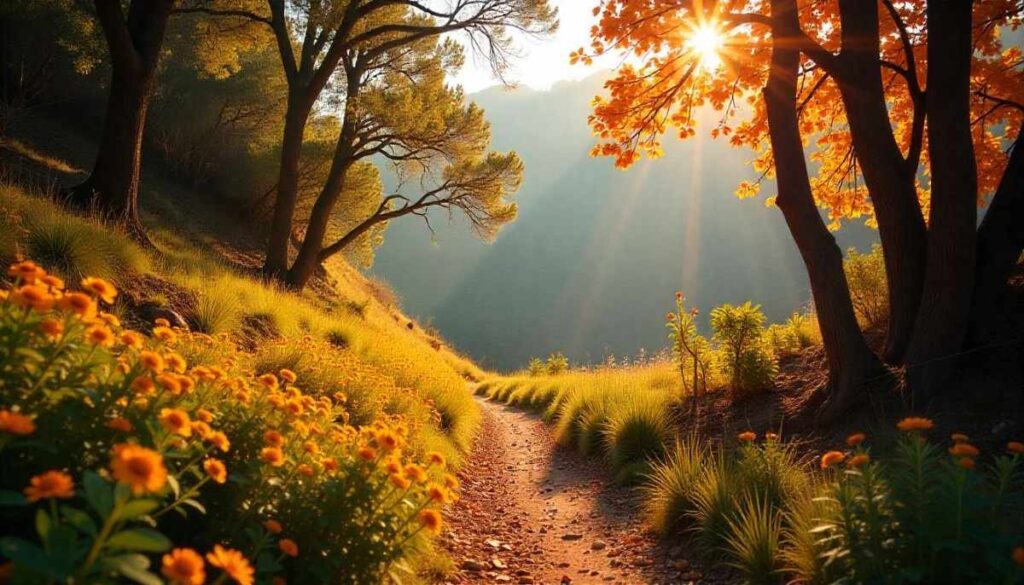
Understanding Malibu’s Mediterranean climate is key to planning safe, enjoyable hiking in Malibu adventures. Each season brings unique conditions—from spring blooms to winter rains—so tailoring your itinerary to the weather and trail accessibility will maximize your outdoor experience. Below, we break down what to expect each season and share expert tips to keep you comfortable and safe on Malibu hiking trails year-round.
Spring Wildflower & Malibu Falls Hike Season
From March through May, hiking in Malibu California shines as canyons burst with native wildflowers—golden poppies, lupine, and phacelia carpeting trails like the Solstice Canyon Loop Trail. Waterfalls such as those on the Escondido Falls Hike flow strongest after winter rains, rewarding early-morning hikers with misty, photogenic cascades. Expert insight: Start hikes before 9 AM to avoid afternoon crowds and bring waterproof boots, as muddy sections can be slippery after rain runoff. This season also marks peak bird migration, so carry binoculars for a chance to spot coastal species.
Summer Shade Hikes & Water-Focused Trails in Malibu
Summer in Malibu can heat up quickly, with inland canyons reaching the high 80s °F. To beat the heat, focus on shaded routes—Malibu creek state park hiking along Sycamore Grove offers dappled canopy cover and creek crossings to cool off. Point Dume Cove Trail and El Matador Beach Coastal Trail also provide refreshing ocean breezes and tide-pool detours. Pro tip: Pack at least two liters of water per person, apply reef-safe sunscreen, and set out no later than 7 AM to enjoy cooler temperatures and softer light for photography.
Fall Canyon Colors & Malibu Canyon Hiking
As temperatures dip into the 60s–70s °F in September through November, canyon vegetation shifts to warm ambers and russets—Malibu canyons take on dazzling fall hues. Trails like Corral Canyon Trail showcase golden oak leaves against blue Pacific backdrops, creating one of the most scenic places in Malibu. Local advice: Bring a lightweight fleece for dawn starts, and consider hiking on weekdays to experience quieter canyons. Fall also has lower fire risk, making previously restricted areas like parts of the Backbone Trail more accessible.
Winter Hiking in Malibu: Rain & Trail Access
Winter brings sporadic heavy rains that can briefly close trails due to erosion or flooding, especially along washes in Zuma Canyon Malibu. However, January to February hikes reward with near-empty paths and vibrant green hillsides. Safety tip: Always check the Los Angeles County Flood Control District advisories and trail status via the Santa Monica Mountains National Recreation Area website before setting out. Wear quick-dry layers and consider waterproof gaiters—after storms, seasonal streams like those at Parker Ranch Vista Point offer dramatic, roaring flows.
Conclusion: Plan Your Best Hikes in Malibu California
As you’ve discovered throughout this guide, hiking in Malibu is far more than a simple walk—it’s an immersive journey through rugged canyons, ocean-topped ridges, ancient redwoods, and hidden waterfall grottos. From the sweeping panoramas along the Backbone Trail (Malibu Segment) to the family-friendly paths at Charmlee Wilderness Park, there truly is a hiking place in Malibu to match every skill level and every season.
By following our detailed insights on trail difficulty, seasonal timing, and essential gear—plus expert safety tips like checking tide schedules at El Matador Beach Coastal Trail or carrying extra water on the exposed switchbacks of Tuna Canyon Park Trail—you’ll set yourself up for a safe, rewarding adventure. Remember to consult park websites for permit requirements and trail conditions before you go.
Whether you’re chasing the roar of Escondido falls hike, seeking a sunrise summit at Parker Ranch Vista Point, or simply craving a leisurely Malibu lake trail stroll, this guide has armed you with the knowledge to choose the best hikes in Malibu and plan your perfect outing. Lace up your boots, respect the Leave No Trace principles, and get ready to experience why Malibu’s scenic trails rank among Southern California’s most unforgettable outdoor adventures.
FAQs About Hiking in Malibu
Where to Stay While Hiking in Malibu?
Whether you’re tackling the Backbone Trail or exploring the Solstice Canyon Loop Trail, you’ll find a variety of lodging options near Malibu’s trailheads. Cozy beachfront inns in West Malibu and charming bed-and-breakfasts near Leo Carrillo State Park offer quick access to hiking in Malibu CA, while campgrounds at Malibu Creek State Park provide rustic comfort steps from the forest.
Are Hiking Trails Open Year-Round in Malibu?
Yes—most hiking trails in Malibu remain open throughout the year, thanks to Southern California’s mild climate. However, winter storms can trigger temporary closures for safety or erosion control, so always check trail status on the California State Parks website before heading out.
What to Do in Malibu Beach CA for Hikers?
After your point dume cove trail or Malibu lake trail adventure, cool off with tide-pool exploration at El Pescador or sunset strolls along Zuma Beach. Pack a picnic, visit the historic Adamson House, or grab a post-hike meal at Malibu Farm Café to recharge and enjoy coastal culture.
Can You Bring Dogs on Malibu Trails?
Many popular routes—like the Solstice Canyon and Malibu Creek State Park hiking trails—welcome leashed dogs, making dog friendly hikes in Malibu easy to find. Always verify rules at each trailhead, carry waste bags, and respect wildlife by keeping pets under close control.
Ethan Marlowe is an experienced hiker and outdoor gear specialist based in Colorado. With over 7 years of hands-on experience trekking through the Rockies, Pacific Northwest, and East Coast trails, he delivers practical advice, expert gear reviews, and survival insights. His goal is to help hikers of all levels make smarter decisions on and off the trail.


